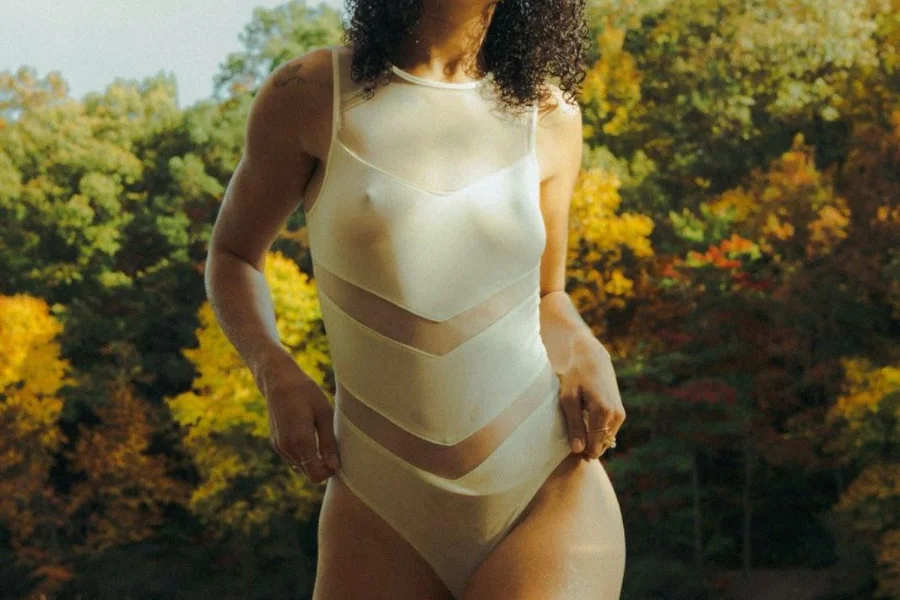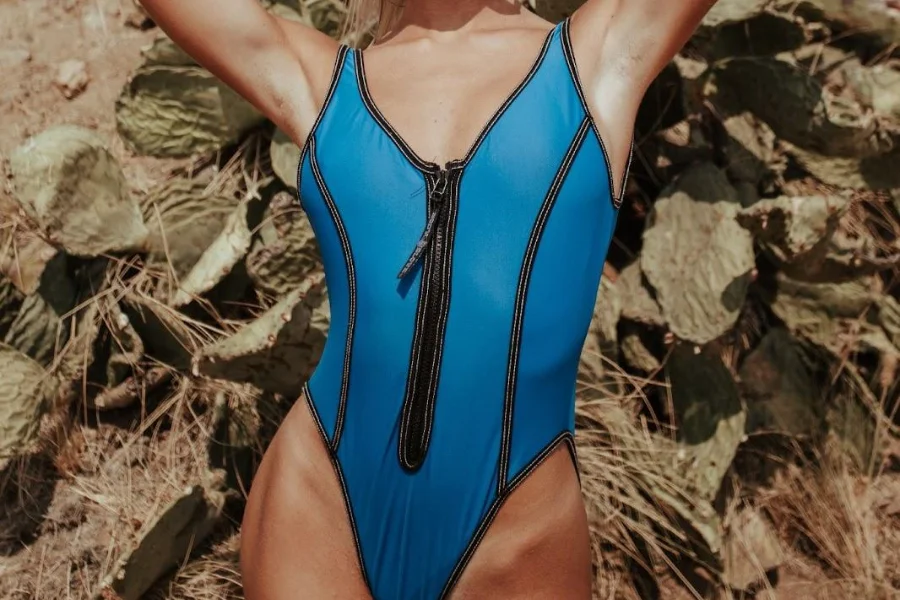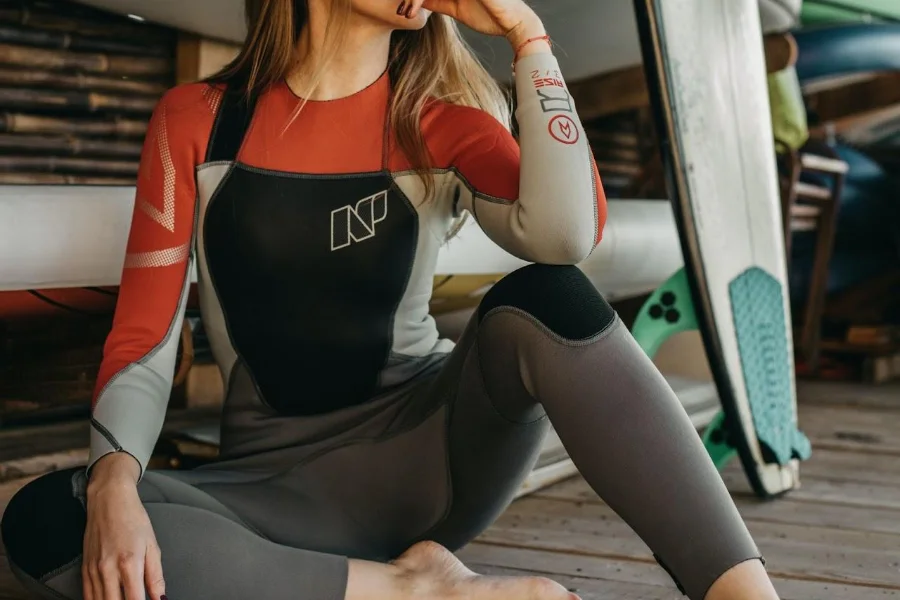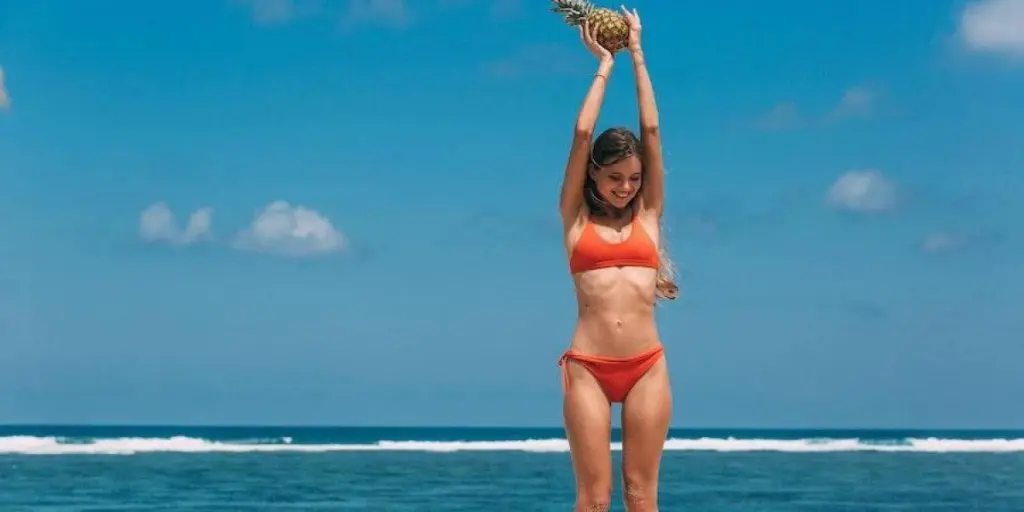Swimming returns this season with benefits that go beyond good cardio workouts. The outdoor activity now serves as a channel for community connections, allowing women of all ages to reconnect with society—while looking stylish.
This season, retailers can make performance swimwear appealing to every woman by updating them with trendy prints and exciting seasonal colors. Investing in the right catalog will keep the sales coming.
Explore five women’s adventure swimwear trends sellers can’t afford to miss before A/W 23/24 sales kick-off.
Table of Contents
Overview of the global women’s swimwear market
5 outstanding swimwear trends for women in A/W 23/24
Rounding up
Overview of the global women’s swimwear market

Swimwear is a broad category relevant to consumers involved in water-based activities, like bathing and swimming. Interestingly, items under this niche can protect the wearer from seawater and chlorinated swimming pools, making them the go-to for anyone interested in taking a dip. The rising popularity of water-based sports and activities has helped push this market to new heights.
The global swimwear market moved from a US $21.18 billion value in 2022 to US $22.6 billion in the early stages of 2023 at a compound annual growth rate (CAGR) of 6.7%. Experts predict the industry will expand to US $28.84 billion by 2027 at a 6.3% CAGR.
Based on fabric type, experts divide the market into polyester, nylon, and spandex. Polyester generated the highest share of the global industry’s 2018 revenue (33.4%) due to the fabric’s resistance to shrinkage and stretching and quick-dry properties.
While nylon is another significant fabric type making rounds in the market, it only works as an alternative polyester. Despite the material’s excellent elasticity, lightweight, and smooth-fitting properties, it’s experiencing a crawling growth rate. This slow expansion is attributable to nylon’s low resistance to chlorine and durability.
The women’s segment emerged as the dominant market in 2018, and research suggests it will experience a 6.6% CAGR over the forecast period. This awaited expansion is attributable to the increasing demand for swimwear among women as more want to look stylish at the beach or pool.
Regionally, Asia-Pacific operates as the largest market for swimwear products. Some factors fostering the region’s impressive growth include the increasing population, rising health awareness among consumers, and the permeation of product innovations.
Europe is the second-largest regional swimwear market, with North America falling closely behind. Western countries account for a significant market share because of the increasing acceptance of swimwear in the region.
5 outstanding swimwear trends for women in A/W 23/24
1. Performance swimsuit

This timeless and flexible core style exudes a versatile appeal that is perfect for wild swimming and trips to the beach and pool. Performance swimsuits maintain classic, effortless silhouettes, ensuring styles look flattering on various body types.
But that’s not all. Retailers can use these attractive pieces to appeal to a broader market. More importantly, performance swimsuits adopt a crossover strap feature as a fashion-led alternative to performance-driven racer-back styles.
Most importantly, the performance swimsuit takes on a high neckline to incorporate streamlined strength and chest compression. Furthermore, retailers can include an inner shelf bra offering the performance attributes of supportive sports bras.
Sellers can also offer options with tummy-control linings for extra torso compression. In addition, designs with contrasting side paneling can create a flattering silhouette that contours the feminine body.
Performance swimsuits have durable fabrics featuring four-way stretch properties for enhanced movement. It also provides anti-microbial treatments to keep consumers safe and comfortable.
2. Rash suit

It’s tough to beat the rash suit regarding a multi-activity appeal. This swimwear is a swim and surf stable that includes an interesting detachable buoy detail, allowing consumers to showcase style even underwater.
In addition, rash-stye swimsuits come with appealing protective designs guarding the wearer against various weather elements. For instance, the piece features full-length long sleeves, which makes it ideal for autumn and winter. In addition, rash suits offer a high-neck design, providing impressive heat retention properties.
Retailers can stock up on variants with long zipper details, allowing wearers to dress and undress them quickly. Opt for rash suits with bright-colored detachable buoys to increase visibility in case of danger. The safety feature is ideal for women swimming in darker waters (like lakes) or during winter with poor lighting conditions.
Provide the wearer with options by including a clip-on-belt to the design, allowing them to wear it around the waist or attach it to the zipper. This safety-focused swimwear comes in bioprene fabrics. Although thin, the material retains traditional neoprenes’ cold water and element protection.
3. Cold water suit

Cold water suits are practical wetsuits that blend functionality and visually appealing designs, providing consumers with pieces that stand out. In addition, the item upgrades the traditional wetsuit silhouette with understated design features, like notched high-neck collars with invisible zippers.
Most cold water suits feature smaller waistlines and enough room for the wearer’s bust, creating a wearable silhouette. In addition, these variants cut the design at the waist to make contrasting tops and bottoms. As a result, half of the swimsuit can feature eye-catching prints, while the other complements with a solid color.
Interestingly, this unique approach fuels the illusion that the cold water suit is a two-piece item. Plus, the design accentuates the wearer’s waist, creating a mouth-watering look. In addition, cold water suits come in bioprenes, making them environmentally friendly compared to other petroleum-based neoprenes.
More importantly, this eco-friendly fabric imbues the cold water suit with neutral buoyancy and heat retention properties.
4. Buoyancy vest

These items are not typical swimwear. In truth, buoyancy vests are optional safety layers that women can wear alone or over their favorite swimsuits, keeping themselves safe for various water activities.
Interestingly, buoyancy vests have center-front zips making them easy to wear. In addition, they feature lightweight designs that consumers can rock throughout the seasons. Although this trend is primarily ideal for big-wave surfers, innovators are pushing buoyancy vests toward a wider demographic.
Although buoyancy vests are incredibly similar to life jackets, consumers won’t be able to inflate and deflate the piece on demand. However, retailers can offer self-inflating variants as an alternative, allowing women to blow air into the vest through a mouthpiece.
Moreover, sellers must avoid advertising buoyancy vests as life-saving items. Instead, they’re perfect for assisting swimmers familiar with open waters. Most of these items come in lightweight bioprenes or performance nylon, depending on the retailer’s budget.
5. Pre- and post-swim layers
Fashionable swimwear is not just about swimsuits. Retailers can offer outer-layer separates, providing women with modularity for styling and warmth. In addition, the trend involves opting for classic tracksuit silhouettes that tap into activewear designs.
Ideally, consumers should also be able to rock these items as leisurewear and style them with wardrobe staples like leggings, hoodies, or shorts. Although these swim layers look attractive, they prioritize functionality over other factors.
For example, the shell can provide windproof and waterproof properties, while the lining offers warm and absorbent features. Variants offering hidden hoods zipped into the neck provide extra protection, while long-side seam zippers make the bottoms easy to slip on and off.
Fabric-wise, these functional swim layers utilize microfibers sourced from recycled materials. For this reason, consumers can enjoy water-wicking, fast-absorbing, and quick-drying properties, especially when layering these items for quick post-swim activities.
Retailers can swap soft polyester for eco-membranes and bio-based fibers for a weather-proof and protective shell outer layer.
Rounding up
Swimwear trends are evolving and enforcing the need to prioritize active performance, function, and fit. This season, retailers can swap traditional swimwear fabrics with innovative eco-friendly options compatible with wild swimming accessories.
In addition, A/W 23/24 swimwear creates items with a multi-wear appeal to provide longevity and high-quality investments. Furthermore, these trends can help sellers appeal to the average consumer using fashionable details, prints, and colors.
For boosted sales this season, businesses must leverage performance swimsuits, rash suits, cold water suits, buoyancy vests, and pre- and post-swim layer women’s adventure swimwear trends.




